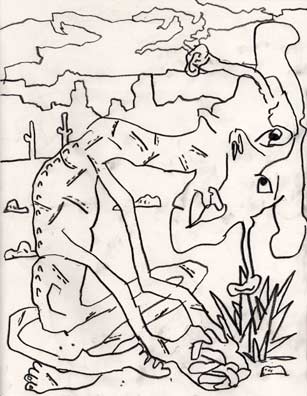
 |

"wiped_homespun_Sedona"
Tucked away in the U.S. Forest Service guide for Red Rock Country, Coconino National Forest and Sedona, Arizona is a reference to a Northern Arizona University survey which found in a recent year that 64% of those visiting the area came seeking a spiritual experience of some sort. Sedona's towering wind and rain sculpted rock formations annually receive four million visitors - “a large number considering the prime attraction is rust,” quips the guide. (The rocks contain iron oxide which through exposure to the elements over millions of years has oxidized, giving the stone its signature blazing orange cast.)
Laid down in the Paleozoic Era, the rock formations of Sedona are the remains of what was once the bedrock upon which the first terrestrial life forms put down roots. As those plants and amphibians ascended, the land undergirding their development slowly surrendered to countless eons of relentless wind and rain – a process of pure creative destruction resulting in the fantastic forms remaining at this moment.
For visitors, the lure is a landscape whose beauty is a function of its decay. This is in striking counterpoint to the situation in the valley where surging urban development is creating a new environment and even newer decay. Like history’s greatest tsunami, humans are, in effect, accelerating the impact of countless eons of weather.
In the same way that one could think of the Red Rocks as the infrastructure upon which terrestrial life built its paradise, so the human development which now fills Sedona’s valley, climbs its mountains and - come to think of it - encircles the globe is the infrastructure suited to our perceived needs and purposes. It feels, here, as though humanity is an alighting hitchhiker saying to the undergirding rocks, “thanks for the ride, but we’ll take it from here.”
Where will this unprecedented endeavor deliver us? How can we successfully negotiate the shoals to escape catastrophe and emerge as richer, wiser, worthy heirs of our earthly progenitor?
Perhaps an answer lies with that 64% who visit Sedona in quest of spiritual experience.
The rise of art making as a human activity (truly a new thing under the sun) dates to about 40,000 years ago. Its appearance is an event that, not coincidentally, roughly coincides with the emergence of the first deleterious impacts of human activity on the environment – for example the hunting to extinction of certain large mammals.
Perhaps the making of art is an evolutionary adaptive response fashioned to re-inject beauty and meaning into a world suffering from human-induced environmental stress. The ongoing genius revelation of our art-making ancestors is that creativity is the ultimate renewable resource.
To the extent that access to the beauty and sustenance of the natural world diminishes, the need for beauty and its orienting connection to awe increases in proportion - awe being the healthy default of human nature. As human activity compromises the inherited beauty of the natural world, we find it biologically incumbent to create beauty from that nature which remains available to us: our own.
From this perspective, those spiritual seekers drawn to Sedona come as nascent artists efforting under the tutelage of the land’s unfathomable beauty to turn yearning into healing.
Posted by mark at January 19, 2004 12:35 PM